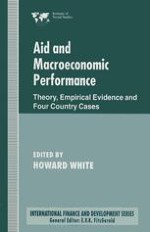1998 | OriginalPaper | Buchkapitel
Nicaragua
verfasst von : Rob Vos, Sara Johansson
Erschienen in: Aid and Macroeconomic Performance
Verlag: Palgrave Macmillan UK
Enthalten in: Professional Book Archive
Aktivieren Sie unsere intelligente Suche, um passende Fachinhalte oder Patente zu finden.
Wählen Sie Textabschnitte aus um mit Künstlicher Intelligenz passenden Patente zu finden. powered by
Markieren Sie Textabschnitte, um KI-gestützt weitere passende Inhalte zu finden. powered by
Foreign assistance to Nicaragua underwent major changes during the 1980s and 1990s. First, on average, the level of aid increased substantially (see Figure 6.1). In 1991, aid inflows rose to almost 60 per cent of GNP, attaining a value in absolute terms nearly three times that of exports. Second, the origin of aid shifted: while aid came primarily from the formerly socialist countries in the 1980s, together with some European assistance from Sweden, Spain and the Netherlands in particular, more broadly based Western support was obtained in the 1990s from the USA, Europe and multilateral agencies. Third, there have been substantial changes in the forms of aid and the conditions attached to it. In the 1970s, foreign assistance mainly took the form of project aid, while in the 1980s, and even more so in the 1990s, it was mainly commodity and balance of payments support. While in the 1980s the socialist countries’ assistance to Nicaragua consisted mainly of nonliquid commodity support, i.e. little spendable foreign exchange, the balance of payments support from the USA and Western Europe provided mainly liquid finance in the 1990s.
